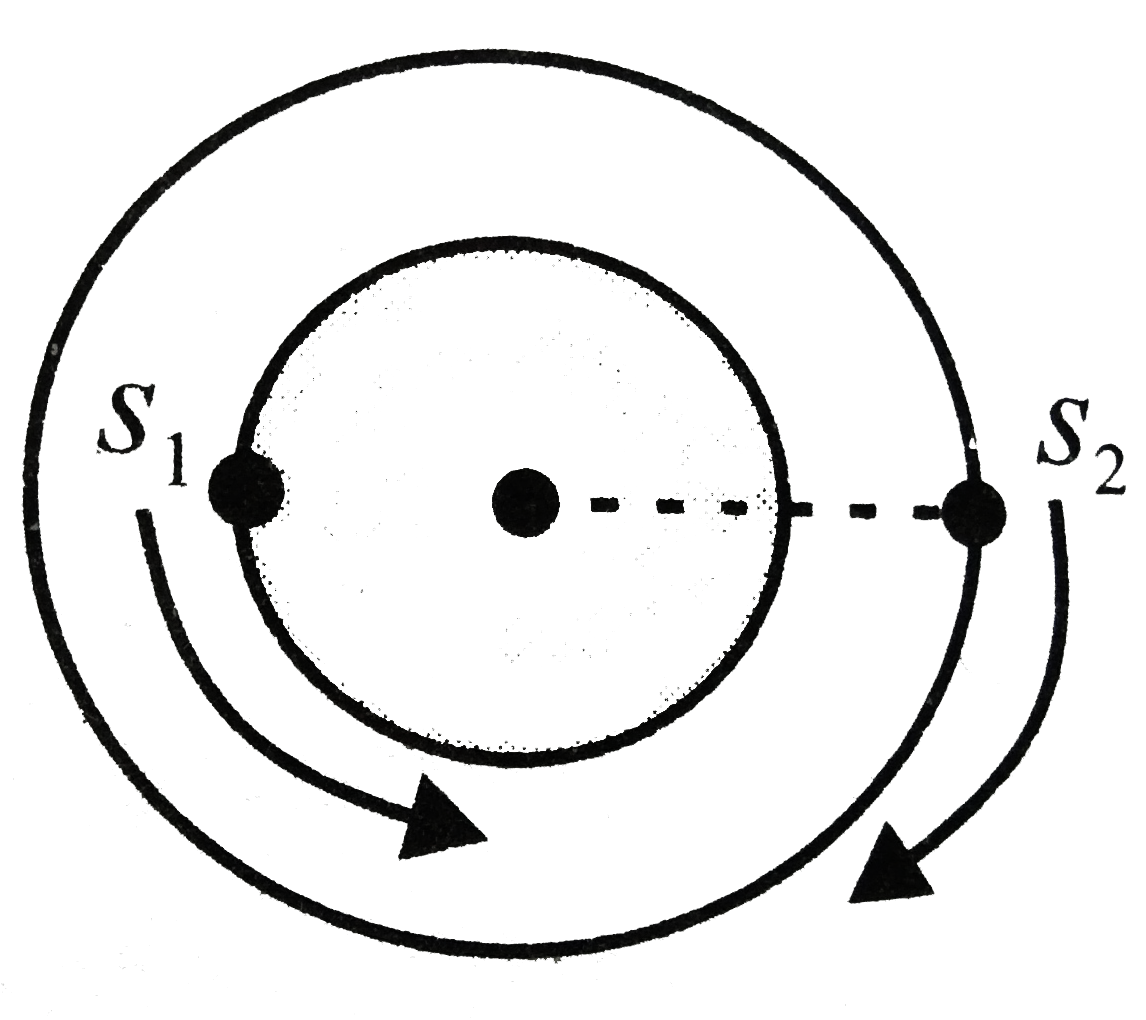Two heavenly bodies S1 and S2, not far off from each other are ssen to revolve in orbit
around their common centre of mass
which are orbitrary
with S1 fied and S2 moving rounds S1
with S2 fixed and S1 moving round S2
The correct Answer is:A
Topper's Solved these Questions
- GRAVITATIONALBOOK - AAKASH SERIESCHAPTER - GRAVITATIONALEXERCISE - EXERCISE -1B
46 Videos
- GRAVITATIONALBOOK - AAKASH SERIESCHAPTER - GRAVITATIONALEXERCISE - EXERCISE-2
146 Videos
- GRAVITATIONALBOOK - AAKASH SERIESCHAPTER - GRAVITATIONALEXERCISE - EXERCISE -3
154 Videos
- GRAVITATIONBOOK - AAKASH SERIESCHAPTER - GRAVITATIONEXERCISE - ADDITIONAL PRACTICE EXERCISE (LEVEL-II) PRACTICE SHEET (ADVANCED)Integer Type Questions
6 Videos
- HORIZONTAL CIRCULAR MOTIONBOOK - AAKASH SERIESCHAPTER - HORIZONTAL CIRCULAR MOTIONEXERCISE - ADDITIONAL PRACTICE EXERCISE (PRACTICE SHEET (ADVANCED) Integer Type Questions)
3 Videos
Similar Questions
Two microwave sources S1 and S2 are located at a distance of 4λ from each other along Y-axis,with S1 at the origin as shown in the figure.A microwave detector D moves along the X-axis away from S1 .The first maximum is obtained for x equal to: (wavelength of the microwave is
View SolutionTwo satellites S1 and S2 are revolving around the earth in coplanar concentric orbits in the opposite sense. At t=0, the position of satellites are shown in the diagram. The periods of S1 and S2 are 4h and 24h, respectively. The radius of orbit of S1 is 1.28×104km. For this situation, mark the correct statement (s).

View Solution
Knowledge Check
Two heavenly bodies s1&s2 not far off from each other, revolve in orbit
Aaround their common centre of massBs1 is fixed and s2 revolves around s1Cs2 is fixed and s1 revolves around s2Dcannot sayTwo satellites S1 and S2 are revolving around the earth in coplanar concentric orbits in the opposite sense. At t=0, the position of satellites are shown in the diagram. The periods of S1 and S2 are 4h and 24h, respectively. The radius of orbit of S1 is 1.28×104km. For this situation, mark the correct statement (s).
 AThe angular velocity of S2 as observed by S1 at t=12h is 0.468πrads−1BThe two satellites are closet to each other for the first tme at t=12h and then after every 24h they are closet to each other.CThe orbital velocity of S1 is 0.64π×104km.DThe velocity of S1 relative to S2 is continuously changing in magnitude and direction both.
AThe angular velocity of S2 as observed by S1 at t=12h is 0.468πrads−1BThe two satellites are closet to each other for the first tme at t=12h and then after every 24h they are closet to each other.CThe orbital velocity of S1 is 0.64π×104km.DThe velocity of S1 relative to S2 is continuously changing in magnitude and direction both.Two coherent light sources S1 and S2(λ=6000Å) are 1mm apart from each other. The screen is placed at a distance of 25cm from the sources. The width of the fringes on the screen should be
A(a) 0.015cmB(b) 0.025cmC(c) 0.010cmD(d) 0.030cm
Two coherent light sources S1 and S2(λ=6000Å) are 1mm apart from each other. The screen is placed at a distance of 25cm from the sources. The width of the fringes on the screen should be
View SolutionTwo satellites S1 and S2 revolve round a planet in the same direction in circular orbits. Their periods of revolutions are 1 hour and 8 hour respectively. The radius of S1 is 104 km. The velocity of S2 with respect to S1 will be -
View SolutionTwo satellites S1 and S2 revolve round a planet in coplaner circular orbit in the same sense. Their period of revolution are 1 hour and 8 hour respectively. The radius of the orbit of S1 is 104km. When S2 is closest to S1, find
(a) The speed of S2 relative to S1,
(b) The angular speed of S2 actually observed by an astronaut is S1
View SolutionTwo satellites S1 and S2 are revolving around a planet in the opposite sense in coplanar circular concentric orbits. At time t = 0, the satellites are farthest apart. The periods of revolution of S1 and S2 are 3 h and 24 h respectively. The radius of the orbit of S1 is 3×104 km. Then the orbital speed ofS2 as observed from
View SolutionConsider two satellites S1 and S2 with periods of revolution 1 hr. and 8hr. respectively revolving around a planet in circular orbits. The ratio of angular velocity of satellite S1 to the angular velocity of satellites S2 is:
View Solution
